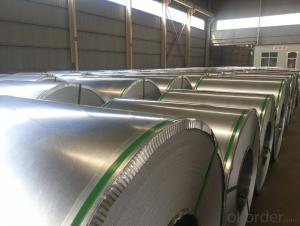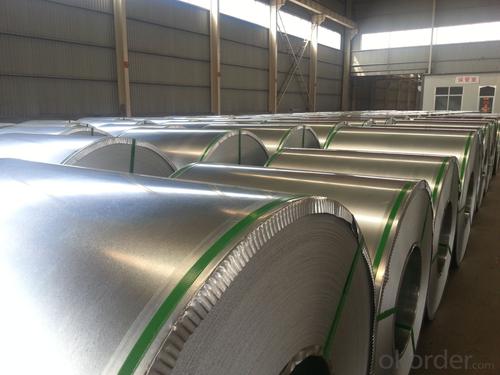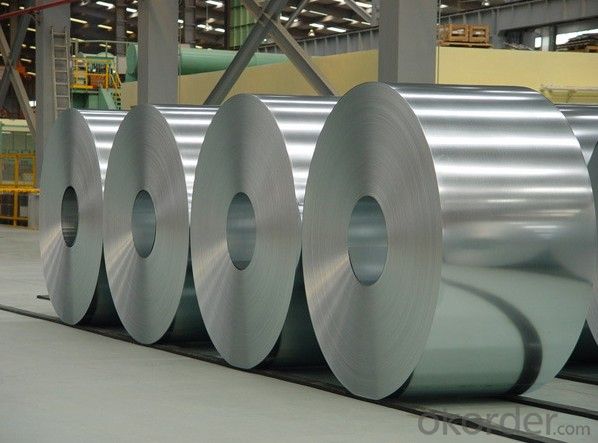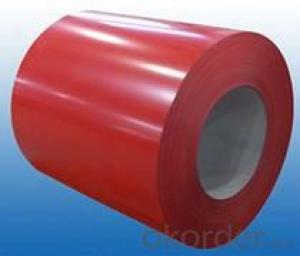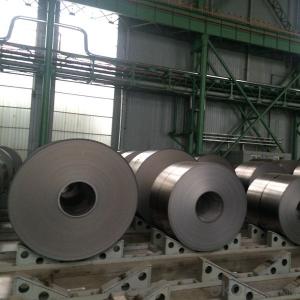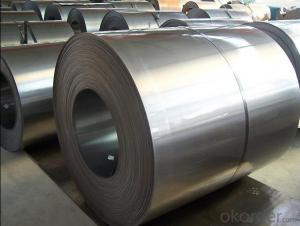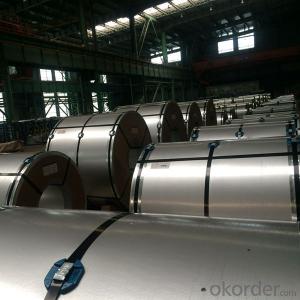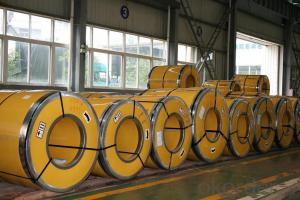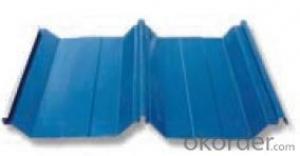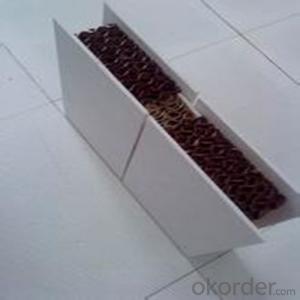Hot dipped galvanized steel sheets/coils DX51D
- Loading Port:
- Tianjin
- Payment Terms:
- TT OR LC
- Min Order Qty:
- 2 m.t.
- Supply Capability:
- 200000 m.t./month
OKorder Service Pledge
OKorder Financial Service
You Might Also Like
Hot dip galvanized steel coil and sheet | |
Technical Standard: | JIS 3302 / ASTM A653 / EN10143 |
Grade | DX51D / DX52D/ DX53D/ S250,280,320GD |
Types: | Commercial / Drawing / Deep Drawing / Structural quality |
Width | 500/650/726/820/914/1000/1200/1219/1220/1250mm |
Thickness | 0.12-4.0mm |
Type of coating: | Galvanized |
Zinc coating | Z30-700g/m2 |
Surface Treatment | Chromed / Skin-pass/ Oiled/Slightly Oiled/ Dry/ Anti-fingerprint |
Surface structure: | Zero spangle / minimized spangle / regular spangle/ big spangle |
ID coil | 508mm or 610mm |
Coil weight | 3-12 MT per coil |
Package: | Properly packed for ocean freight exportation in 20''containers |
Application: | Industrial panels, roofing and siding for painting |
Price terms | FOB,CFR,CIF |
Payment terms | T/T or L/C |
Delivery time | Within 30 days |
Remarks | Insurance is all risks |
MTC will be handed on with shipping documents | |
We accept the third party certification test,such as SGS/BV |
Technical data :
Hot dipped galvanized coil Technical Data
Chemical Composition | ||||||
GRADE | C | Si | Mn | P | S | Ti |
SGCC/DX51D+Z | ≤0.10 | ≤0.50 | ≤0.60 | ≤0.10 | ≤0.030 | ≤0.020 |
DX52D+Z | ≤0.10 | ≤0.50 | ≤0.60 | ≤0.10 | ≤0.030 | ≤0.020 |
SGCD/DX53D+Z | ≤0.10 | ≤0.30 | ≤0.50 | ≤0.05 | ≤0.030 | ≤0.020 |
SGCE/DX54D+Z | ≤0.10 | ≤0.30 | ≤0.30 | ≤0.03 | ≤0.020 | ≤0.020 |
DX56D+Z | ≤0.10 | ≤0.30 | ≤0.30 | ≤0.03 | ≤0.020 | ≤0.020 |
Structural | ≤0.20 | ≤0.60 | ≤1.70 | ≤0.10 | ≤0.045 | |
Hot dipped galvanized steel coil Mechanical Properties | |||
GRADE | Yield Strength MPa | Tensile Strength MPa | Elongation % |
SGCC(DX51D+Z) | ≥205 | ≥270 | - |
SGCD(DX53D+Z) | - | ≥270 | 38 |
SGCE(DX54D+Z) | - | ≥270 | 40 |
DX56D+Z | - | ≥270 | 42 |
- Q: How is the quality of steel sheets determined?
- The quality of steel sheets is determined by several factors and tests. One of the primary factors is the chemical composition of the steel, which includes the presence and percentage of various elements such as carbon, manganese, silicon, and alloying elements like chromium, nickel, and molybdenum. The specific composition affects the steel's strength, durability, and resistance to corrosion. Another important aspect is the mechanical properties of the steel, which are assessed through tests such as tensile strength, yield strength, elongation, hardness, and impact resistance. These tests help determine the steel's ability to withstand applied forces and deformation without failure. Surface quality is also crucial in determining the quality of steel sheets. The surface should be free from defects like cracks, scratches, pits, or any other irregularities that could affect the performance or appearance of the steel. Furthermore, the thickness and uniformity of the steel sheets are crucial factors. Thickness is measured using methods like ultrasonic gauges or micrometers to ensure compliance with the required specifications. Any deviations from the specified thickness can affect the structural integrity and performance of the steel sheets. Additionally, the steel sheets undergo various tests to assess their weldability, formability, and machinability, which determine their suitability for specific applications. These tests help evaluate the steel's behavior during fabrication processes like welding, bending, or machining. Overall, the quality of steel sheets is determined by a comprehensive evaluation of their chemical composition, mechanical properties, surface quality, thickness, and other specific performance characteristics. These assessments ensure that the steel sheets meet the required standards and are suitable for the intended applications.
- Q: What are the different surface textures for pre-painted steel sheets?
- There are several different surface textures for pre-painted steel sheets, including smooth, matte, textured, embossed, and patterned.
- Q: Can steel sheets be used for electrical grounding purposes?
- Certainly! Electrical grounding purposes can indeed utilize steel sheets. Steel, being an excellent conductor of electricity, is well-suited for grounding applications. By appropriately linking them to an electrical system, steel sheets can offer an efficient route for the discharge of electrical charges and the avoidance of electrical shock risks. Nevertheless, it is crucial to guarantee that the steel sheets are suitably bonded and connected to the grounding system to establish a path of low resistance for fault currents. Furthermore, factors like the thickness and surface area of the steel sheets should be taken into account to ensure they satisfy the criteria for effective grounding.
- Q: Are steel sheets susceptible to warping or bowing?
- Yes, steel sheets are susceptible to warping or bowing under certain conditions. This can occur due to factors such as temperature changes, uneven cooling, or excessive stress during manufacturing or handling. However, proper design, fabrication, and installation techniques can minimize these risks and ensure structural integrity.
- Q: What are the different bending radius options for steel sheets?
- The bending radius options for steel sheets can vary depending on the thickness and type of steel being used. Generally, the bending radius for steel sheets ranges from 0.5 to 2 times the thickness of the sheet. For thinner sheets, such as those with a thickness of 0.5mm to 2mm, a bending radius of 0.5 to 1 times the sheet thickness is typically recommended. This allows for a tighter bend without risking cracking or deformation of the steel. For thicker sheets, such as those with a thickness of 2mm to 6mm, a bending radius of 1 to 1.5 times the sheet thickness is commonly used. This ensures that the steel retains its structural integrity and prevents any excessive stress or strain during the bending process. For even thicker sheets, typically above 6mm, a bending radius of 1.5 to 2 times the sheet thickness is often required. This larger bending radius helps to avoid any potential damage or distortion to the steel, ensuring a successful bending operation. It is important to note that these bending radius options are general guidelines and may vary depending on the specific steel grade, composition, and intended application. It is always recommended to consult the manufacturer's recommendations or seek expert advice when determining the appropriate bending radius for steel sheets.
- Q: Can steel sheets be painted or coated after installation?
- Yes, steel sheets can be painted or coated after installation. Painting or coating steel sheets after installation is a common practice to enhance their appearance, protect against corrosion, or meet specific design requirements.
- Q: What are the different types of steel sheet finishes for architectural applications?
- There are several different types of steel sheet finishes that are commonly used for architectural applications. These finishes not only enhance the aesthetic appeal of the steel sheets but also provide protection against corrosion and other environmental factors. 1. Mill Finish: This is the most basic type of finish, where the steel sheet is left as it comes from the mill. It has a dull, gray appearance and is typically used for applications where aesthetics are not a priority. 2. Brushed Finish: Also known as a satin finish, this type of finish is achieved by brushing the steel sheet with a fine abrasive material. It gives a smooth, linear texture to the surface, resulting in a contemporary and elegant appearance. 3. Polished Finish: This finish is achieved by polishing the steel sheet with abrasive materials until it becomes smooth and reflective. It provides a high-gloss, mirror-like appearance, making it suitable for applications that require a sophisticated and luxurious look. 4. Embossed Finish: In this finish, the steel sheet is pressed with embossing tools to create textured patterns or designs on the surface. This gives the sheet a unique and decorative appearance, making it ideal for architectural applications where visual interest is desired. 5. Patterned Finish: This finish involves applying a pattern or texture onto the steel sheet using various techniques like etching, laser cutting, or perforating. It creates a visually appealing surface with intricate designs, making it suitable for both functional and decorative purposes. 6. Powder Coated Finish: In this finish, a layer of dry powder paint is electrostatically applied to the steel sheet and then cured under heat. It provides a durable and vibrant finish, available in a wide range of colors and textures. This finish is highly resistant to chipping, scratching, and fading, making it ideal for exterior architectural applications. 7. Galvanized Finish: This finish is achieved by applying a layer of zinc coating onto the steel sheet through a process called galvanization. It provides excellent corrosion resistance, making it suitable for outdoor architectural applications where the steel sheet is exposed to harsh environments. Overall, the choice of steel sheet finish depends on the desired aesthetics, durability, and environmental conditions of the architectural application.
- Q: Can steel sheets be used for manufacturing kitchen utensils?
- Yes, steel sheets can be used for manufacturing kitchen utensils. Steel is known for its durability, heat resistance, and corrosion resistance, making it a suitable material for utensils used in the kitchen. Steel sheets can be shaped and formed into various utensil designs, providing strength and longevity to the products.
- Q: What is the weight of steel sheets?
- The weight of steel sheets can vary depending on their size, thickness, and density. However, on average, steel sheets can range from a few pounds to several hundred pounds per square foot.
- Q: What are the applications of steel sheets in construction?
- Due to their exceptional strength, durability, and versatility, steel sheets find a wide range of applications in the construction industry. Some of the key uses of steel sheets in construction are: 1. Roofing and cladding: Steel sheets are commonly employed in both residential and commercial buildings for roofing and cladding purposes. They offer a long-lasting and weather-resistant solution, safeguarding the structure against the elements. 2. Structural components: Steel sheets are utilized to construct beams, columns, and trusses, which are essential structural components. The high strength-to-weight ratio of steel enables the creation of lightweight yet robust structures capable of withstanding heavy loads and seismic forces. 3. Flooring: In industrial buildings, warehouses, and factories, steel sheets are often used as flooring material. Their smooth surface facilitates easy cleaning and maintenance, and their strength and fire-resistant properties ensure a safe working environment. 4. Wall partitions: Steel sheets are commonly used in the construction of wall partitions due to their stability and sound insulation properties. They can be easily cut and shaped to fit any design, allowing for flexible and customizable partition layouts. 5. Ductwork and HVAC systems: Steel sheets find extensive use in the fabrication of ductwork and HVAC systems. Their smooth and airtight surfaces enable efficient air movement and regulation, ensuring proper ventilation and temperature control in buildings. 6. Reinforcement: Steel sheets are frequently integrated into concrete structures as reinforcement. This enhances the strength and load-bearing capacity of the building, making it more resistant to bending, tension, and compression forces. 7. Safety and security: Steel sheets are utilized in the construction of safety and security features such as doors, gates, and window frames. Their high strength and resistance to impact and vandalism make them an ideal choice for ensuring the safety and protection of a building. In conclusion, steel sheets play a crucial role in construction for various applications, including roofing, cladding, structural components, flooring, wall partitions, ductwork, reinforcement, and safety features. Their superior strength, durability, and versatility make them an indispensable component in different construction projects, contributing to the overall safety, longevity, and functionality of buildings.
Send your message to us
Hot dipped galvanized steel sheets/coils DX51D
- Loading Port:
- Tianjin
- Payment Terms:
- TT OR LC
- Min Order Qty:
- 2 m.t.
- Supply Capability:
- 200000 m.t./month
OKorder Service Pledge
OKorder Financial Service
Similar products
Hot products
Hot Searches
Related keywords
